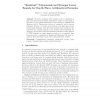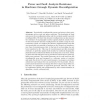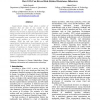570 search results - page 2 / 114 » The behavior of resistive circuits |
VTS
2005
IEEE
13 years 11 months ago
2005
IEEE
We present three resistive bridging fault models valid for different CMOS technologies. The models are partitioned into a general framework (which is shared by all three models) a...
COCOON
2007
Springer
13 years 11 months ago
2007
Springer
We derive quadratic lower bounds on the ∗-complexity of sum-of-products-of-sums (ΣΠΣ) formulas for classes of polynomials f that have too few partial derivatives for the techn...
VLSID
2004
IEEE
14 years 5 months ago
2004
IEEE
Abstract--In this paper, we present a new approach to calculate the steady state resistance values for CMOS library gates. These resistances are defined as simple equivalent models...
CHES
2008
Springer
13 years 7 months ago
2008
Springer
Dynamically reconfigurable systems are known to have many advantages such as area and power reduction. The drawbacks of these systems are the reconfiguration delay and the overhead...
HICSS
2007
IEEE
13 years 12 months ago
2007
IEEE
Organizational change brings about a number of behaviors that are seen to run counter to the implementation of the information systems. These behaviors may be seen as jeopardizing...



